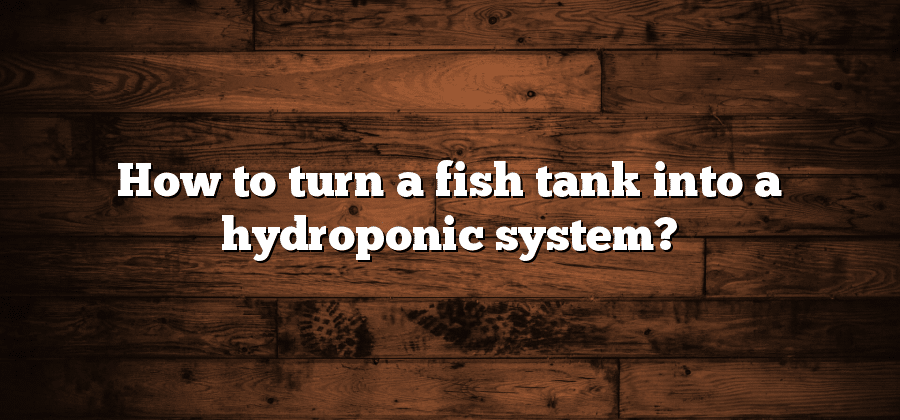Understanding the Basics of Hydroponics
Hydroponics is a cutting-edge gardening technique that allows plants to grow without the use of soil. Instead, they are grown in a nutrient-rich water solution which provides them with all the essential elements they need to thrive. This method of gardening offers several advantages over traditional soil-based systems, making it a popular choice among garden enthusiasts.
One of the key benefits of hydroponics is that it allows plants to grow faster and produce higher yields. This is because the plants do not need to expend energy searching for nutrients in the soil; instead, the nutrients are readily available in the water solution. Additionally, hydroponics eliminates the risk of soil-borne diseases, as well as the need for pesticides and herbicides. This makes it a more environmentally friendly and sustainable way to grow plants. Whether you have limited outdoor space, poor soil quality, or simply want to explore a new and innovative gardening method, hydroponics could be the ideal solution for you.
Choosing the Right Fish Tank for Hydroponics
When it comes to choosing the right fish tank for hydroponics, there are several factors to consider. Firstly, the size of the tank is crucial. The tank should be large enough to accommodate a sufficient number of plants and provide them with the necessary space to grow. Additionally, the tank should also be sturdy and durable to withstand the weight of the water and the system’s components. A quality fish tank made from materials such as acrylic or glass is recommended.
Furthermore, the design of the fish tank should be taken into account. Opt for a tank with easy access to the plants and the water circulation system, as this will make maintenance and monitoring much more convenient. Additionally, consider the shape of the tank – rectangular or square-shaped tanks are typically better suited for hydroponics systems, as they provide more surface area for plant growth. Lastly, consider any additional features such as built-in filters or drainage systems that can contribute to the overall efficiency and functionality of the hydroponics setup.
Essential Equipment for Converting a Fish Tank
Fish tanks can be transformed into effective hydroponic systems with the right equipment. One of the essential items needed is a water pump. This pump helps circulate the water in the tank and provides the necessary oxygen for the plants’ roots. A good water pump should be reliable, energy-efficient, and have adjustable flow rates to meet the specific needs of the plants. Additionally, a timer can be used to automate the water pump’s operation, ensuring the plants receive a consistent water supply.
Another important piece of equipment for converting a fish tank into a hydroponic system is an air pump. An air pump is responsible for providing oxygen to both the fish in the tank and the plant roots. It helps prevent the water from becoming stagnant and promotes the healthy growth of the plants. When choosing an air pump, it is crucial to consider its noise level, power consumption, and the ability to regulate airflow. Investing in a high-quality air pump will ensure the optimal oxygenation of the system, ultimately resulting in healthier plants and fish.
Setting Up the Water Circulation System
When it comes to hydroponics, setting up the water circulation system is a vital step in creating the optimal growing environment for your plants. The water circulation system ensures that the nutrient-rich water is evenly distributed to all the plants in the system, promoting healthy growth and development.
There are several key components involved in setting up the water circulation system. First and foremost, you will need a pump that is capable of circulating the water effectively. It is important to choose a pump that is the right size for your system, as using an undersized or oversized pump can lead to issues such as insufficient water flow or excessive noise. Additionally, you must consider the type of pump you need, whether it be a submersible or an external pump, based on the specific requirements of your hydroponic system.
Selecting the Ideal Growing Medium for Plants
When it comes to hydroponics, selecting the ideal growing medium for plants is crucial for their growth and overall health. The growing medium serves as a substitute for soil and provides support, aeration, and moisture retention for the plant’s roots. There are various types of growing mediums available, each with its own advantages and disadvantages.
One commonly used growing medium is rockwool, which is made from spun volcanic rock or mineral fibers. Rockwool has excellent water retention capabilities and provides good support for the plants. Another popular choice is coco coir, a natural fiber derived from coconut husks. Coco coir has excellent water retention and aeration properties, making it a suitable medium for hydroponic systems.
Some other options include perlite, which is a lightweight volcanic glass that provides good drainage and aeration, and vermiculite, a mineral-rich medium that retains moisture well. Additionally, clay pellets, also known as hydroton or expanded clay, are highly popular due to their excellent drainage capabilities.
Ultimately, the choice of growing medium depends on various factors such as the type of plants being grown, the specific hydroponic system being used, and personal preferences. It is advisable to conduct thorough research and experiment with different growing mediums to find the ideal one that promotes optimal plant growth and productivity in your hydroponic system.






